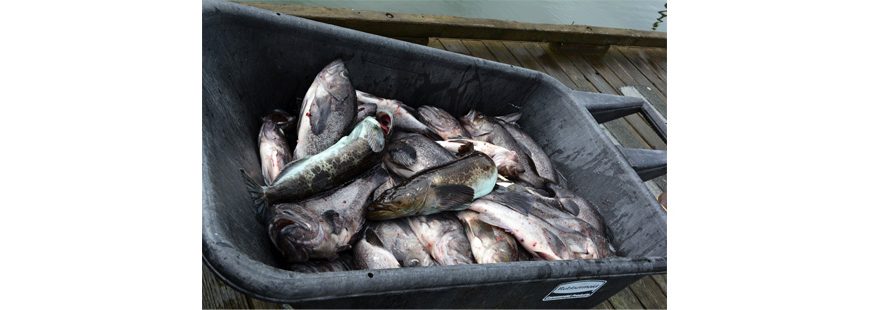Photo: A day’s catch of seabass and lingcod
Like many sportsmen, we rely on fall to fill our freezers and what oftentimes feels like an insatiable need to harvest. I’m not sure I can explain it, but before I had the ability to drive, let alone work a rod, reel or rifle, I poured copious amounts of time into a 10 X 4 foot plot of soil, growing vegetables for my family.
Thankfully, not all of us are born with that drive; this planet couldn’t handle that kind of pressure. I remain in awe however, once again realizing what our Pacific Northwest waters are capable of “throwing up.”
This time, black rockfish were our target with a strong hope for some dandy lingcod as well.
Black rockfish make up the bulk of the biomass for the rockfish complex off the Oregon coast. I’m sure anyone that has bottom-fished off of Oregon’s coast has brought home a mess of these fish and frankly, after a dismal spring Chinook season, a cooler full of fish has been a welcome change.
Well, the south and sunken jetty of the lower Columbia River did not disappoint. With a boat-load of newcomers to bottomfishing, the excitement was notable.
Slowly, but surely, bass were hitting the deck one by one, but even with this biomass coming on board, I’ve seen this fishery much more productive than this. We only once had a quadruple, and these are fairly more frequent in this highly productive fishery. We certainly didn’t walk away disappointed; with our 56 seabass and three lingcod, everybody took home a nice haul.
It wasn’t that long ago when the limit on bass was ten, and even before that, there wasn’t any limit at all. We humans have systematically compromised these stocks of fish, going from one species to another until reactive measures have to be implemented to prevent a stock collapse. It’s always hard to remember, since history rarely makes headlines, but the examples are many:
- We first started harvesting salmon in the rivers and estuaries with the use of gillnets and fish wheels. When we wiped out the freshwater stocks, we turned to an ocean troll fleet. When those stocks were no longer being finished sustainably, and the collapse of the coho came reigning down on us in the 80s, we went to a restrictive Chinook and coho quota system. Now it takes an entire staff of biologists, on the state, federal and tribal level, along with a myriad of stakeholders, to determine and negotiate which stocks of salmon can be harvested in what directed fisheries. And that’s just a snapshot in salmon fisheries.
- When the salmon stocks collapsed on the Columbia River, sport anglers, charters and fishing guides switched their target species over to sturgeon. After a strong 20-year run, sturgeon stocks have dipped below harvestable levels, and now there is no consumptive opportunity downstream of Bonneville Dam. We collectively harvested hundreds of thousands of 13 to 25-year-old adults from this fishery.
- Also when salmon stocks collapsed, the commercial and charter boat fleet switched to targeting bottom fish to sustain their customer bases. That’s when we progressively started seeing more restrictive opportunity that I’ve mentioned above.
The examples go on and on, but my point is we have proven time and time again that these incredible resources are finite. Even with the bounty we collected this spring, these fisheries have to be proactively and conservatively managed.
Fresh off another “fishing trip” to Washington DC, fishing for another highly sought after species, the Magnuson-Stevens Act yet remains to be re-authorized. The good news is, that’s a good thing as the current version actually rolls back protective measures that have enabled us to take advantage of once again abundant stocks of fish.
The recent El Niño event and the anomaly of the warm water blob in the Gulf of Alaska remind us, once again, that there are challenges ahead that we have no idea what their impact will be. Climate change and ocean acidification are just the ones we know about, and we have yet to realize the full brunt of these threats. What else lies ahead isn’t even at the speculative stage yet.
Now is not the time to rollback protections that have proven to be effective, but it is time to have a greater conversation about how to build ocean resiliency and plan for the future. No matter how dysfunctional this Congress is, it’s up to our community to continue to bring the message of the importance of these ocean resources to our families and communities, so there is opportunity for future generations of fisherman. And speaking of ocean resiliency, NOAA is offering up some significant grant money for your ideas and projects on how to build on this strategy in your community.
Now celebrate our wonderful spring opportunities by posting your favorite spring fishing adventure and hopefully the photographic proof of what a wonderful place we live in!


